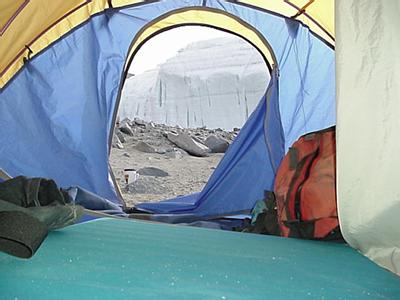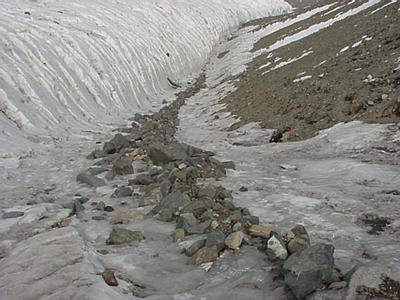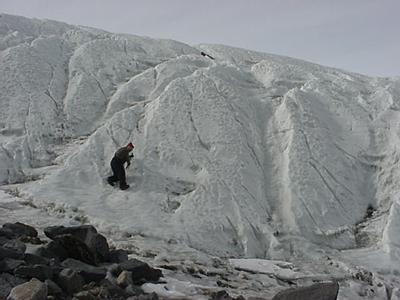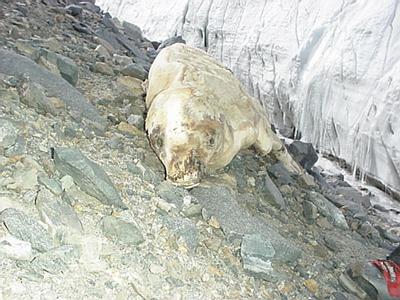7 December, 1999
Tuesday December 7, 1999
Woke up at 0730. I slept like a baby, the temperature was probably 15oF, but
I was as warm as toast. Only problem was my toothpaste froze. Straightened
up my tent, boy did it need it. Then I just laid back and starred for about
1/2 hour at the most gorgeous scene not more then 20 meters from my "front
door". I am truly blessed to be here. Then I got dressed and went down to
have tea. I met Thomas (Nylen), the glaciologist, he said to meet him back
at his lab at about 1030 hours. When I showed up he handed me a pair of
crampons, cleats that you wear on your boots that allows you to climb ice
walls; and an ice pick. This is used as a walking stick, an ax and a safety
device. We were off to do science and I was as happy as a penguin in -1.28o
Celsius water. Yahoo!
.
He had two tasks: one to drill out a new hole for a bamboo pole not too far
from my tent and the other to climb up on top of the glacier and measure a
pole's new position. What Thomas does is to monitor the movement of the
glacier. He drills a hole into the ice and places a bamboo pole into it and
then over time sees what happens to its depth in the ice, its slope and its
location on the earth..
Once the hole is drilled he takes four measurements from the surface to the
top of the pole and averages them together. This provides the average
height out of the, since it is not perfectly vertical. Thomas then measures
the inclination (slope) of the pole and the slope of the ice with a tool
called an inclinometer. Each pole is tagged with a brass marked and each
has its GPS position fixed to within I believe a millimeter.
The first pole, as I said was probably 30 meters from my tent, required the
most work other then the walking with 40- 60-lb packs on our back. We had
to carry everything we needed: gasoline drill, drill bits (they come in
meter long sections we had four with us), equipment, supplies, water bottle,
pea bottles, trail mix and the ever present cameras.
Thomas had to climb up on the face of the glacier and drill a 3 1/2-meter
deep hole to put a pole in place. I stayed below and handed him the
equipment and shot some video that he was making for his family for
Christmas. Thomas is a soft spoken, extremely knowledgeable, most
responsible, most meticulous and a very pleasant young man. I am honored
that I had the chance to work with, and actually to help this young
dedicated scientist. Thomas is finishing up his Ph.D. work at Portland State
where he has been working for Dr. Andrew Fountain.
This process took probably 40 minutes, then we left the drill and augers
there, grabbed our backpacks and started to climb and climb and climb. I am
not afraid to admit this was totally exhausting. We had great weather ,
relatively mild and a gentle breeze; but I had to stop and rest and to get a
drink. This was perfectly fine with Thomas. When I ever swung around to
look back from where we came, what I saw was amazing. First to realize that
we had traveled so far and so high, and then the view.
We had been walking on the left gravel and rock strewn side of the Canada
Glacier. Between us and the glacier there was a "valley" (maybe 20 meters
wide) where the glacier had receded and left behind an almost a perfect row
of glacial moraine. I had commented to Thomas that it looked like the stone
walls we find in New England. He agreed. It really was amazing. From our
vantage point we could see Lake Hoare far below and to the right,
immediately in front and to our left was the Canada glacier and far beyond
it were five other peaks with glaciers in between each. It is almost a
religious happening. We had stopped just in front of one of Thomas' 100+
flagged poles. As we were standing looking at it from about 30 meters away
and another 20 meters above, it calved. That's right, we were there just at
that moment when the ice that it had been placed into many years ago,
probably to a depth of 3 1/2 meters had ablated and/or moved away. This
was less likely to see, then winning the lotto "big game". I was impressed
and when I saw how impressed Thomas was I was really impressed.
After resting we proceeded further up this valley (I would guess a mile +/-)
to a point where the glacier wall became about 20 meters tall and had much
less steepness to it. Here Thomas, very patiently I might add, helped me
put on my crampons. These crampons go over your boot and they have tweleve
1 inch by a 1/2-inch teeth that you must force, all twelve, into the ice to
prevent from slipping. The danger is slipping and sliding to your death
(or at least needing some serious body work) or if your lucky, ripping you
leg open on the crampons.
There is no way I can describe how hard glacier ice is. I swung my ice pick
as hard as I could and maybe penetrated 2 ". It really is amazing. Thomas
gave me some lessons on how to use the crampons and the ice ax. The plan was
for him to proceed to the top of the glacier and I was to go only part of
the way up. My task was to "sneak up upon and capture" the different
equipment as Thomas needed it.
While on top of the glacier Thomas asked me to proceed up valley and read
the identification numbers on the next two pole. This I did, very gingerly
I might add, and with great trepidation. But I did what I was asked to do.
Ya!
I shot some video footage of Thomas descending the glacier face. Then we
sat and talked for a while. I am truly impressed with this young gentleman.
We had some trail mix and water and started back for Lake Hoare field camp.
Going down the mountain was not as easy as I thought it would be,
especially with a full backpack. As we proceeded down the mountain Thomas
went down and to the left, stopped and beckoned me to come and take a
look. There laying, at least 500 feet above the valley (Lake Hoare) floor,
oh ya, and at least 15 or 20 miles from the nearest ocean, was a dead, I
think, crab eater seal. It was totally in tack and because of the cold and
extreme dryness was totally preserved. "Mummified". Wow, first a penguin
and now a seal. What wonderful place I am in.
From here we had about another 30 minutes to camp. We got there just as we
said we would when we signed out, 1430 hours. I brought my gear to the main
camp and came in and made myself a tea. Then I started downloading pictures.
I had a number of shots of Thomas and I told him I would put them on a disk
for him. This I did and he was quite impressed. He now has something he
can send to his special lady friend back in Portland. Actually, he asked
if he could borrow my camera and I had to reluctantly say no, for it was not
mine to let other people use. He said he understood. I hope so, for I
would not want to offend such a fine man.
I went back to my tent and slept for a couple of hours, then just laid there
staring at the Canada Glacier from my "bedroom". Tough life we live here in
Antarctica. I came to the main camp and ate dinner and spent the rest of
the night on this journal.
I also notified Eian, the NZ hydrologist, that I would not be going into
the field with him on Thursday. Barbara wanted to go to a place called
mummy pond and I think she had to be with some one in order to go there. It
will be fun and maybe I'll learn why they call it mummy pond.
Until tomorrow.
Penguin Pete the Polar Man
I

Inside my home. <> Photo by Peter M. Amati, Jr.

A view from my verandah. <> Photo by Peter M. Amati, Jr.

Glacial moraine. These rocks mark the farthest advance that this glacier had made. If it stays stationary and then starts to retreat debris builds . <> Photo by Peter M. Amati, Jr.

"Mountaineer" Penguin Pete "strikes" again. <> Photo by Thomas Nylen

Mummified seal. Notice how high this seal is up the side of the mountain, and what you cannot see is that its about 15 miles to the Ross Sea. <> Photo By Peter M. Amati, jr.
Contact the TEA in the field at
.
If you cannot connect through your browser, copy the
TEA's e-mail address in the "To:" line of
your favorite e-mail package.
|
